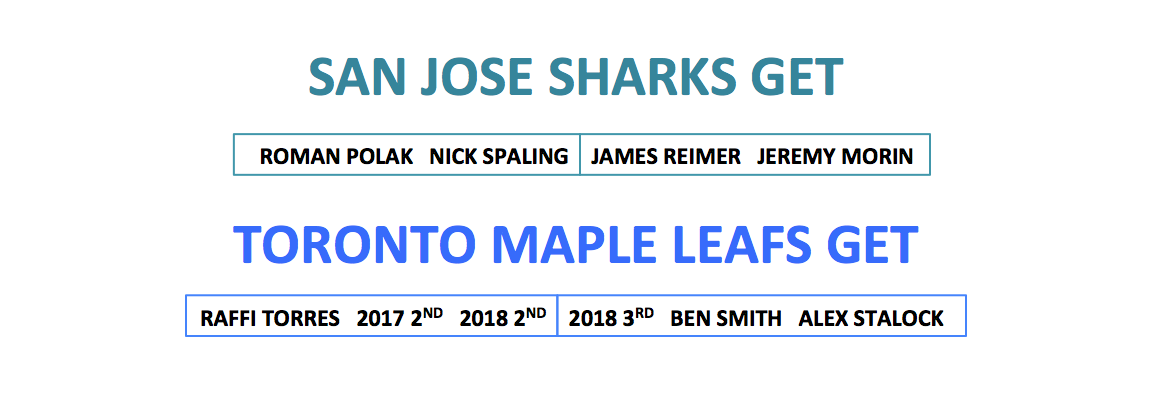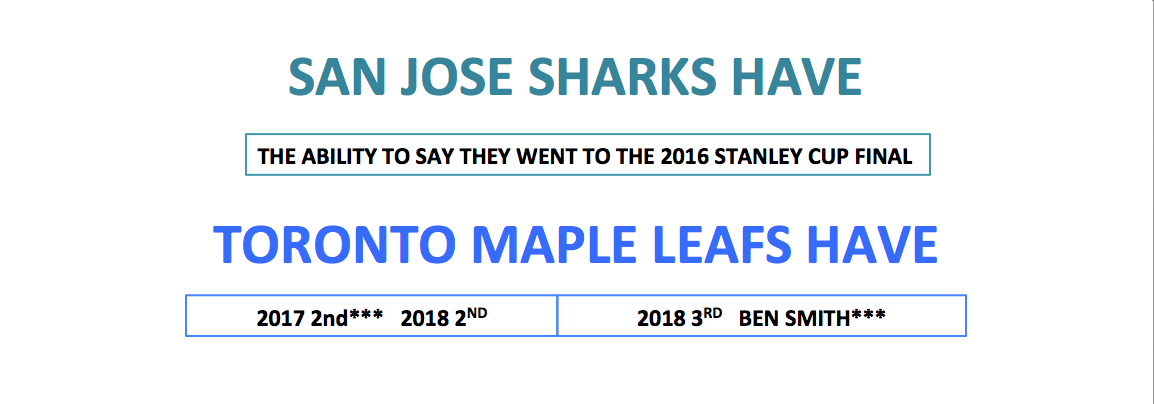Last week I went into depth on the infamous Vesa Toskala trade between the Leafs and Sharks. The trade tree for that deal is so long that not only did it not all fit on my marker board but it’s also still expanding.
Coles notes: The deal was so bad for the Leafs that teams who weren’t even involved in the trade made off better than they did.
This time we’ll go through a Leafs-Sharks trade that isn’t much of a trade tree just yet. What do we call that?
A sapling.
During the Leafs’ 2015-16 fire sale that helped Toronto plummet into last place in the league, the Leafs traded Roman Polak to the San Jose Sharks for a decent haul.
Now, before we get into the Polak deal, we need to decide what it is.
The actual trade was San Jose acquiring Polak and forward Nick Spaling in exchange for two second-round picks and the remainder of Raffi Torres’ contract. Not bad, considering Spaling was somewhat of a cap dump for the Penguins in the Phil Kessel deal. This trade was made on Feb. 22, 2016, well ahead of the 2016 trade deadline, and gave many fans the impression the Leafs could trade any expiring contract they had for the sun and the moon.
Those fans were likely disappointed when, just five days later, the Leafs and Sharks made another deal. The Sharks acquired James Reimer and perennial mystery sort-of-prospect Jeremy Morin in exchange for goalie Alex Stalock, centre Ben Smith, and a conditional fourth-round pick. That’s not exactly two second-rounders now, is it?
Because of this, and since the trades were made within less than a week of each other, many fans like to treat the two deals as if they are one. I think that’s pretty fair. Do we agree that two second-rounders is a lot for Polak? Do we also agree that a conditional fourth-rounder and two cap dumps – that’s pretty much what Smith and Stalock were at the time – is practically nothing for Reimer? I say let’s combine them and it becomes a more even deal.
So now we have…

We have to update this little chart, if you can call it that, because both teams got a bit of good news from the Reimer portion of the trade. The condition on the 2018 fourth-rounder the Leafs received in the Reimer deal was that if the Sharks made it to the 2016 Stanley Cup Final, the pick turns into a third-rounder. The Leafs improve the pick they received and the Sharks get a ticket to the big dance. Ignoring the outcome of the series, both teams are happy.
The 2018 third-rounder is probably especially welcome to the Leafs because Toronto has to surrender their own 2018 third-rounder to the New Jersey Devils as compensation for Lou Lamoriello. Yeah, remember that dumb rule? It cost the Leafs two picks (Babcock, too). Fun stuff.
So now the trade(s) become…

This is what the initial trade, or trades, ended up becoming. A few months changes a lot though. What does this deal look like today, less than one year later?
 The Sharks didn’t retain any of the four players the Maple Leafs gave them last winter. That’s not necessarily a bad thing. After all, they call them “rental” players for a reason.
The Sharks didn’t retain any of the four players the Maple Leafs gave them last winter. That’s not necessarily a bad thing. After all, they call them “rental” players for a reason.
The Leafs’ AHL affiliate, the Toronto Marlies, dismissed Alex Stalock in the spring. The Marlies’ net was crowded, Stalock wasn’t going to be used, and he had a young family waiting for him at home. It was the right decision.
Raffi Torres obviously wasn’t re-signed with the Leafs. I’m not even sure they gave him a jersey.
Oh yeah, and the Leafs signed Polak as a UFA in the summer.
I was listening to the radio today and Andrew Berkshire mentioned that if the Leafs were to trade Polak at the deadline again, similar to Daniel Winnik before him, the haul for the Leafs would be smaller. I would bet that’s correct but let’s throw two factors out there:
1. Last season, Polak carried a $2.75-million cap hit and $3.1-million salary. He now carries a $2.25-million cap hit and salary, so even if his play has decreased, so has his salary.
2. The Leafs could theoretically retain salary on Polak.
But now we’re trading a guy who hasn’t been traded (again) yet. Moving on.
You’ll notice two of the four “assets” the Leafs got have asterisks beside them. The first is for Smith. The Leafs don’t still have him. They had to re-acquire him. Whether it was Smith’s decision, the Leafs’ decision, or a mutual departure, Smith opted to sign with the Colorado Avalanche this past summer. He’s back on the Leafs now because the team claimed him off of waivers early this season. He’s still a Leaf, but if you want to split hairs, you could argue that removes him from the trade tree.
The 2017 second-rounder the Sharks gave the Leafs might end up going to the Anaheim Ducks.
Toronto traded a first-round pick and a conditional second-round pick to Anaheim in exchange for Frederik Andersen. The condition is that the middle pick of the three 2017 second-rounders the Leafs currently own (Toronto, San Jose, and Ottawa), will go to Anaheim. At the moment I’m writing this, the Sharks pick would be the middle one. It’s also mid-December. Lots of hockey to be played.
This isn’t a long and sprawling trade tree like some of the ones I’ve written before but it definitely has the potential to be one. It’s a fun little sapling so far, for sure. Conditions awarded, conditions to be determined, and the potential of more deals in the future.
Let’s revisit this little guy in 10 years or so.












